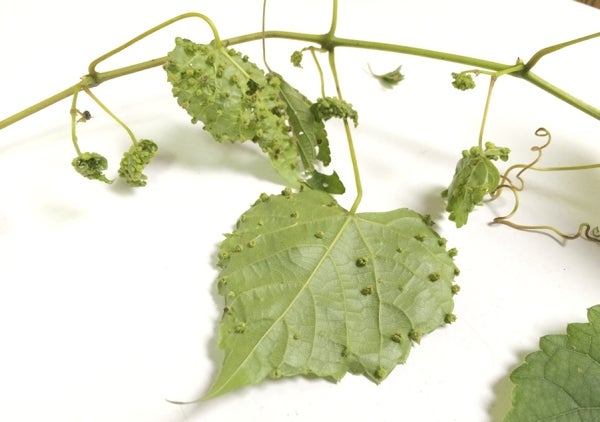Fresh samples, photos of problems help identify them
Published 12:00 am Friday, September 4, 2015

- Cooperative Extension Phylloxera on grape leaves weird bumps. It's best to cut off and destroy the damaged part so it does not spread.
By Danelle Cutting
Rowan Cooperative Extension
As summer temperatures fade and fall’s cooler weather begins, people are venturing out into their gardens and looking at their landscapes. Sometimes, this brings in some interesting questions.
Question: You mentioned Pierce’s Disease on muscadines last week. I’m sure I have it. Should I remove the vines that are not showing symptoms?
Answer: The only vines that should be removed are the ones showing symptoms. The vines that are infected will eventually die from the disease. Removing the vine will help reduce the spread. If you only have two vines and only one is showing symptoms, make sure that your second vine is a perfect flowering type. If the surviving vine is just a female variety, you will need to replace the diseased vine with a perfect flowering type. The good part about this time of year is that it is a great time to plant grapes. The 4-H Plant Sale is gearing up, so call the office to hear about varieties, or visit this link for more information on muscadine varieties: http://www.smallfruits.org/Muscadines/production/MuscadineGuide2003.pdf
Question: Help! My grapes have bumps all over it. I don’t want my grapes to die, and I don’t want this to spread. What do I do?
Answer: The item brought in was grape leaf galls caused by Phylloxera. I mentioned this pest earlier in the year on pecan leaves. This pest does not cause significant damage, but it is unsightly, and the infected material needs to be destroyed. You can burn it or throw it in the trash. Do not leave it on the vine or cut and leave it on the ground, since that will not remove the problem.
Question: How much longer do I have to turn in my soil sample and it still is free?
Answer: The $4 fee will start the first week of December but due to the Thanksgiving holiday, the lab will be closed the week prior to that, so you will need to send it off before then. As always, the North Carolina Department of Agriculture posts the last two years of soil sample reports online and can come in very handy when planting your newly purchased fall plants. I cannot recommend taking soil samples enough because it saves you money from not having to buy or put out the wrong fertilizer, putting out too much or too little fertilizer or lime, and saves you the time in figuring all of that out. Be sure to stop by our office for a soil sample kit. You will be glad that you did.
Question: What is this weed?
Answer: Excellent question. I get this all the time. The problem is that I either get a sample that is incomplete or so old that I cannot tell what it originally was. I need to get the entire plant if possible, usually the roots, and a leaf or twig. A great suggestion is that if the sample is a tree or large shrub, take some photos of the leaves, flowers and bark. If I get plants that are far gone, I cannot tell if it is something from Night of the Living Dead or something from the Black Lagoon. It makes it very difficult for me to identify some key characteristics. So, if at all possible, try to get samples as fresh as possible. For example, if it is a grass, try to get the seed head, leaves and root system. This is also some great advice to help me identify disease and pest problems. Photos and live and fresh specimens in their most complete form (no squished insects, please) will help me solve your problem much quicker.
If you are having issues with your lawn, garden, or just need assistance in creating your garden haven, call your local agent, Danelle Cutting, at 704-216-8970.




